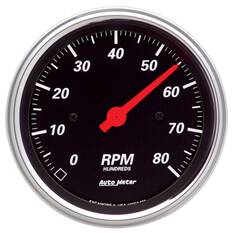Leading Reasons Why Every Driver Needs a High-Quality Tachometer
Leading Reasons Why Every Driver Needs a High-Quality Tachometer
Blog Article
The Significance of a Tachometer in Checking Engine Speed and Efficiency in Automotive Applications
In the realm of auto engineering, the tachometer stands as a critical instrument in the motorist's collection, providing a straight window into the inner operations of a lorry's engine. Beyond its function as a plain gauge of changes per minute (RPM), the tachometer serves as a critical tool for lovers and specialists alike, supplying real-time understandings into engine performance and health.
Significance of Keeping An Eye On Engine RPM
Checking engine RPM, or changes per min, is an important facet of auto upkeep and efficiency analysis. Engine RPM straight correlates with the speed at which the engine's crankshaft revolves, showing just how swiftly the engine is running - tachometer. By keeping an eye on RPM, auto mechanics can examine the health and wellness of the engine, spot potential concerns, and fine-tune efficiency. An uncommon RPM analysis may signal troubles such as engine misfires, defective trigger plugs, or issues with the fuel delivery system. Consistently high RPM readings could indicate hostile driving routines or the requirement for a greater equipment shift to enhance fuel efficiency.
Additionally, keeping track of engine RPM is important for performance examination in auto racing and high-performance cars. In recap, keeping track of engine RPM is not only important for finding issues however additionally for maximizing engine performance in different vehicle applications.

Advantages of Real-Time Information
In automotive applications, real-time data plays an important function in giving instant understandings into the performance and condition of the car. By constantly keeping an eye on numerous criteria such as engine speed, temperature, fuel consumption, and extra, real-time information supplies countless advantages that contribute to enhanced efficiency and safety when driving.
One significant advantage of real-time data is its capacity to sharp vehicle drivers and professionals to any kind of abnormalities or problems immediately. This positive method makes it possible for fast recognition of prospective issues, permitting timely treatments to avoid further damages or failures. In addition, real-time information promotes efficiency optimization by supplying instant comments on driving practices and engine efficiency. Motorists can change their behavior in real-time based upon this info to achieve much better fuel economic situation and extend the lifespan of their lorry.

Furthermore, real-time data plays an important duty in contemporary automobile diagnostics, making it possible for technicians to swiftly diagnose and attend to malfunctions. This results in decreased downtime, reduced upkeep costs, and eventually, improved overall vehicle dependability and long life (tachometer). By taking advantage of the power of real-time information, automotive stakeholders can make educated choices that positively affect both the performance and long life of the vehicle
Effect on Equipment Shifts
Efficient gear shifts in vehicle applications significantly affect overall performance and driving experience. The tachometer plays a critical role in optimizing gear shifts by supplying real-time engine speed information to the vehicle driver. When approaching the redline on the tachometer, it signals the chauffeur to upshift to stop over-revving the engine and creating possible damages. On the various other hand, downshifting at learn the facts here now the appropriate minute can aid keep the engine in its power band, ensuring responsive acceleration when needed.
Furthermore, the tachometer aids in achieving smoother gear shifts, especially in hands-on transmissions. By keeping track of engine speed, drivers can execute gear changes at the optimum RPM range, decreasing snagging motions and decreasing my response endure the transmission elements. This precision on duty modifications not only boosts driving convenience however also adds to sustain efficiency.
Enhancing Gas Effectiveness
Provided the crucial role the tachometer plays in maximizing gear shifts for efficiency and engine wellness, it straight adds to making best use of gas efficiency in auto applications. By supplying real-time responses on engine rate, the tachometer assists drivers in keeping the most reliable RPM variety for gas economic climate. When vehicle drivers constantly keep track of the tachometer and readjust their driving behaviors appropriately, they can stay clear of unnecessary gas intake created by over-revving or lugging the engine.
In addition, the tachometer assists motorists identify the most fuel-efficient gear to be in at any kind of provided minute, avoiding the engine from functioning more difficult than essential. In conclusion, the tachometer serves as an important tool in improving gas effectiveness by advertising optimum driving habits and identifying areas for improvement in the vehicle's performance.

Making Best Use Of Engine Durability
The tachometer's role in checking engine speed and efficiency is important in making certain the durability of automotive engines. Keeping an eye on the tachometer allows drivers to stay within the recommended RPM range for their lorry, avoiding unneeded strain on the engine and prolonging its lifespan.

Verdict
In conclusion, the tachometer plays an essential function in monitoring engine rate and performance in automotive applications. By providing real-time data on RPM, it permits effective gear changes, enhanced gas efficiency, and maximized engine longevity. This tool is crucial for preserving optimum engine performance and making sure the overall performance of a vehicle.
Report this page